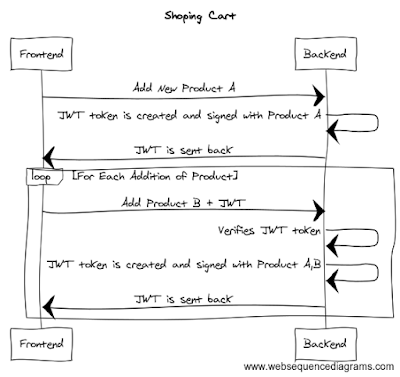

One Jar To Rule Them All: Cloud Native Applications with JWT
source link: http://www.lordofthejars.com/2018/01/cloud-native-applications-with-jwt.html
Go to the source link to view the article. You can view the picture content, updated content and better typesetting reading experience. If the link is broken, please click the button below to view the snapshot at that time.

Cloud Native Applications with JWT
Publicado por Unknown en 1:23 p. m.
- Use a distributed in-memory key/value data store like Infinispan.
- Use a token which acts as a session between client and server using for example JWT.
- When the user adds the first product, the backend service generates a new JWT token with the product added and sent it back to the frontend.
- When the user adds a new product, it sends the product to add and also the JWT token that was sent before by backend.
- Then the backend verifies that the token has not been modified (verifying the signature), then it gets the products from JWT payload added previously and add the new one to the list. Finally, it creates a new token with previous and new products and it sent it back to the frontend.
- The same process is repeated all the time.
- Use HTTPS instead of HTTP
- JWT just signs the token, if you want extra protection apart from HTTPS, use JWE to encrypt the payload of JWT token as well.
- Fingerprinting the token to avoid any man-in-the-middle attack and use these parameters as authentication parameters for the token.
- JWT can be used for passing authentication and authorization things as well.
Turn it up, it's your favorite song (hey), Dance, dance, dance to the distortion, Turn it up (turn it up), keep it on repeat, Stumbling around like a wasted zombie (like a wasted zombie) (Chained to the Rhythm - Katy Perry)Music: https://www.youtube.com/watch?v=Um7pMggPnug
Follow me at https://twitter.com/alexsotob
Recommend
-
 18
18
One Load Balancer to rule them allJuly 12, 2019If you read my introduction, you know I’m a cheap person. A few months ago I worked on a project that had about 10 microservices....
-
 15
15
Lightning Talk: One Language to Rule Them All (IaC in F#)This website uses cookies to improve your experience. Learn more
-
 10
10
One event to rule them allHi, weʼre arkency 👋
-
 8
8
One enum to rule them all Written on 13/03/2021 Jakob Meier Have you ever spent time writi...
-
 10
10
Unicode: On Building The One Character Set To Rule Them All Most readers will have at least some passing familiarity with the terms ‘Unicode’ and ‘UTF-8’, but what is really behind them? At their core...
-
 15
15
Why require one if you can require them all? From the team that brought you lara...
-
 6
6
The NAND gate. One gate to rule them all.Chronicles of my descent into madness.Level 1: The human world.A NAND gate (NOT-AND) is a logic gate which produces an output which is false only if all...
-
 7
7
One Tool to Rule Them All Microsoft released the second iteration of its Page Diagnostics Tool for SharePoint. If you have an SPO site, you NEED this tool in your toolbox! Last week, o...
-
 8
8
GStreamer: one repository to rule them allFor the last years, the GStreamer community has been analysing and discussing...
-
 13
13
Brought to you by From MIT researchers who have an AI system that rapidly predicts how two proteins will attach, to Facebook’s first high-performance self-supervised algorithm that works for spe...
About Joyk
Aggregate valuable and interesting links.
Joyk means Joy of geeK
/cdn.vox-cdn.com/uploads/chorus_image/image/49523369/20150428-cloud-computing.0.jpg)
